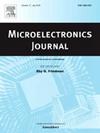一种新的无sha双通道14位125 MS/s流水线ADC的背景带宽校准技术
IF 1.9
3区 工程技术
Q3 ENGINEERING, ELECTRICAL & ELECTRONIC
引用次数: 0
摘要
提出了一种用于无sha管道模数转换器(ADC)的带宽失配校准技术。对于SHA-less ADC,带宽不匹配导致组延迟差异,导致线性度差和码丢失,严重影响高频动态性能。为了解决这一问题,提出了一种新的背景校准技术,该技术可以识别群延迟差异并使用可编程延迟线有效地补偿群延迟差异。为了进一步提高线性度,实现了一种洗牌技术,有效地将谐波失真重新分配到噪声底。采用180 nm CMOS工艺制作了一款无sha的双通道14位125 MS/s原型ADC,在输入信号为13 MHz时,其信噪比和失真比(SNDR)达到72.5 dB,无杂散动态范围(SFDR)达到98.9 dB,在输入信号为493 MHz时,校正后的SFDR从64 dB提高到75 dB,有效缓解了带宽失配引起的非线性。本文章由计算机程序翻译,如有差异,请以英文原文为准。
A novel background bandwidth calibration technique in a SHA-less dual-channel 14-bit 125 MS/s pipeline ADC
This paper presents a bandwidth mismatch calibration technique for SHA-less pipeline analog-to-digital converter(ADC). For SHA-less ADC, bandwidth mismatch causes group delay discrepancy, resulting in poor linearity and missing codes, significantly deteriorating the high frequency dynamic performance. To address this, a novel background calibration technique which identifies the group delay discrepancy and effectively compensates it using a programmable delay-line is proposed. To further enhance linearity, a shuffling technique is implemented, effectively redistributing harmonic distortion into the noise floor. A dual-channel SHA-less 14-bit 125 MS/s prototype ADC is fabricated in a 180-nm CMOS process, reaching signal-to-noise and distortion ratio (SNDR) of 72.5 dB and spurious-free dynamic range (SFDR) of 98.9 dB with a 13 MHz input signal, and improves SFDR from 64 dB to 75 dB with a 493 MHz input signal after calibration, effectively mitigating the bandwidth-mismatch induced nonlinearities.
求助全文
通过发布文献求助,成功后即可免费获取论文全文。
去求助
来源期刊

Microelectronics Journal
工程技术-工程:电子与电气
CiteScore
4.00
自引率
27.30%
发文量
222
审稿时长
43 days
期刊介绍:
Published since 1969, the Microelectronics Journal is an international forum for the dissemination of research and applications of microelectronic systems, circuits, and emerging technologies. Papers published in the Microelectronics Journal have undergone peer review to ensure originality, relevance, and timeliness. The journal thus provides a worldwide, regular, and comprehensive update on microelectronic circuits and systems.
The Microelectronics Journal invites papers describing significant research and applications in all of the areas listed below. Comprehensive review/survey papers covering recent developments will also be considered. The Microelectronics Journal covers circuits and systems. This topic includes but is not limited to: Analog, digital, mixed, and RF circuits and related design methodologies; Logic, architectural, and system level synthesis; Testing, design for testability, built-in self-test; Area, power, and thermal analysis and design; Mixed-domain simulation and design; Embedded systems; Non-von Neumann computing and related technologies and circuits; Design and test of high complexity systems integration; SoC, NoC, SIP, and NIP design and test; 3-D integration design and analysis; Emerging device technologies and circuits, such as FinFETs, SETs, spintronics, SFQ, MTJ, etc.
Application aspects such as signal and image processing including circuits for cryptography, sensors, and actuators including sensor networks, reliability and quality issues, and economic models are also welcome.
 求助内容:
求助内容: 应助结果提醒方式:
应助结果提醒方式:


